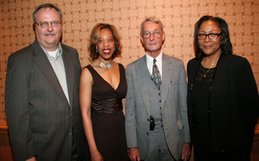We are proud of our 33 Democratic women running for elected office on the state ballot this year and we are also very proud of the Democratic women who are running for election to county elected office. The ODP is hosting a panel discussion for our candidates on July 11th in our HQ. If you know a woman who would like to run for public office in the future, please contact us at the ODP.
Here are some national facts about women and elected office:
Women and Elected Office
- There are only eight women governors, a decrease from the record nine women governors who served before the 2004 Election.
- Washington is the first state to have a woman governor and two women senators all serving simultaneously.
- Five states- New Hampshire, Delaware, Iowa, Mississippi, and Vermont- have never sent a woman to Congress!
(Center for American Women and Politics, www.cawp.rutgers.edu)
- Women make up 51% of the US population, and only 14% of the US Congress.
(The White House Project, www.thewhitehouseproject.org)
- In total, 79 of the 535 members of Congress (both houses) are women (14.7% overall).
- Looking at the young elected leaders of today- 86% are male!
(Eagleton Institute of Politics, Rutgers University, www.eagleton.rutgers.edu)
- Strong majorities of young people believe that having more young people (62%), more women (59%), and more people of color (55%) in office would make government & politics better.
(The White House Project, www.thewhitehouseproject.org)
- Of the nearly 600 people who have served in the President’s cabinet or as cabinet-level officers since Washington’s term, only 29 (or approx. 5%) have been women.
(Center for American Women and Politics, www.cawp.rutgers.edu)
- There have only been 26 women governors in American history, including those serving now.
(Center for American Women and Politics, www.cawp.rutgers.edu) - The proportion of women in the state legislatures has increased very little in the past eight years-from 20.8 percent in 1996 to 22.5 percent in 2004.
- No women of color have ever been governor of a U.S. state.
(Center for American Women and Politics, www.cawp.rutgers.edu)
- Representative Nancy Pelosi (D-CA), the House Democratic Leader, is the first woman to lead her party in Congress.
(Center for American Women and Politics, www.cawp.rutgers.edu)
- Loretta Sanchez (D-CA 47) and Linda Sanchez (D-CA 39) are the first sisters to serve together in Congress.
(Center for American Women and Politics, www.cawp.rutgers.edu)
- Victoria Woodhull, a stockbroker, publisher, and protégé of Cornelius Vanderbilt, ran for president of the United States in 1872 on the Equal Rights Party ticket.
(Center for American Women and Politics, www.cawp.rutgers.edu)
- Third-term Congresswoman Geraldine A. Ferraro (D-NY), was the first woman ever to run on a major party's national ticket as Walter Mondale’s Vice Presidential running mate in 1984 (Center for American Women and Politics, www.cawp.rutgers.edu)
- Of the 11,744 members of Congress, there have only been 223 women elected in the history of the United States.
- If congress and governorships are the pipelines to the presidency then those lines are only sprinkled with women- with 86% of Congress and 84% of governorships held by men. (Center for American Women and Politics, www.cawp.rutgers.edu)
- Half of all of today’s top elected officials- from big city mayors to president- were elected BEFORE they were 35!
(Eagleton Institute of Politics, Rutgers University, www.eagleton.rutgers.edu)
- 12 of the 19 presidents were elected to office at 35 and younger!
(Eagleton Institute of Politics, Rutgers University, www.eagleton.rutgers.edu)
- Americans are ready for gender diversity in leadership.
(The White House Project, www.thewhitehouseproject.org)
- 2 strong reasons why women don’t run for office in the same numbers as men- we need to be invited in to the political system and we downplay our own qualifications!
(Entering the Arena: Gender & the Decision to Run for Office, American Journal of Political Science, Volume 48, Issue 2, April 2004).
- Women public officials do have a gender-related impact on public policy and the political process.
(The Impact Of Women In Public Office, Edited By Susan J. Carroll, Indiana University Press, 2001.)
- Gender differences among public officials are not limited to their impact on public policy but in the way they conduct political business.
(The Impact Of Women In Public Office, Edited By Susan J. Carroll, Indiana University Press, 2001.)
- Women are significantly more likely than men to say that a bill focusing on women was their top legislative priority.
(The Impact Of Women In Public Office, Edited By Susan J. Carroll, Indiana University Press, 2001.)
- Women are more likely to be involved in Women’s Rights Bills, by supporting or signing on to the legislation.
(The Impact Of Women In Public Office, Edited By Susan J. Carroll, Indiana University Press, 2001.)
- 37% of men self identify with politics, while that many women need to be invited in. (Eagleton Institute of Politics, Rutgers University, www.eagleton.rutgers.edu)
- Young women, as well as young men, see politics as something ‘old white men’ do -‘old white men’ who are driven by money and are largely corrupt.
(The White House Project, www.thewhitehouseproject.org)
- All 14 women Senators are white, with only one woman of color ever elected to the Senate, Carol Moseley Braun from Illinois.
(Center for American Women and Politics, www.cawp.rutgers.edu)
- Women of color constitute 3.4% of the total 535 members of Congress.
(Center for American Women and Politics, www.cawp.rutgers.edu)
Additional Resources:
- The Impact Of Women In Public Office, Edited By Susan J. Carroll, Indiana University Press, 2001
- The Eagleton Institute of Politics at Rutgers, The State University of New Jersey, www.eagleton.rutgers.edu
- The White House Project, www.TheWhiteHouseProject.org

No comments:
Post a Comment